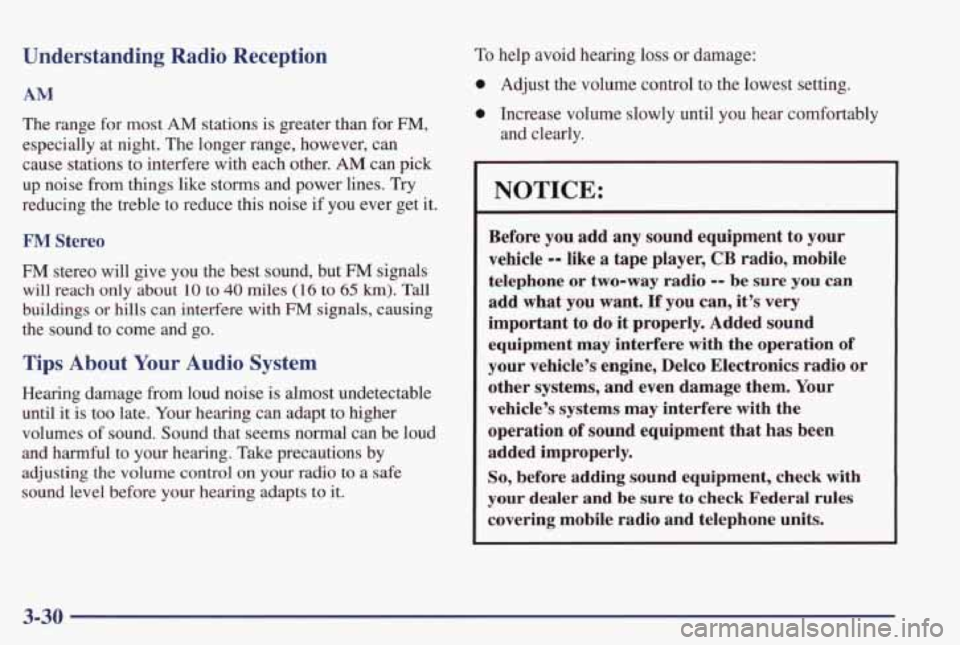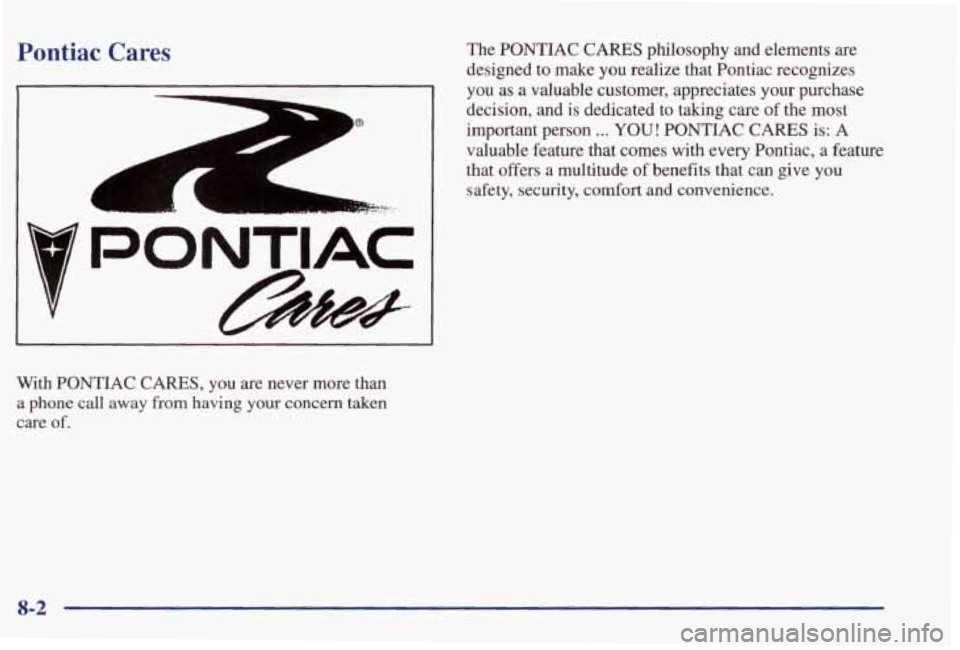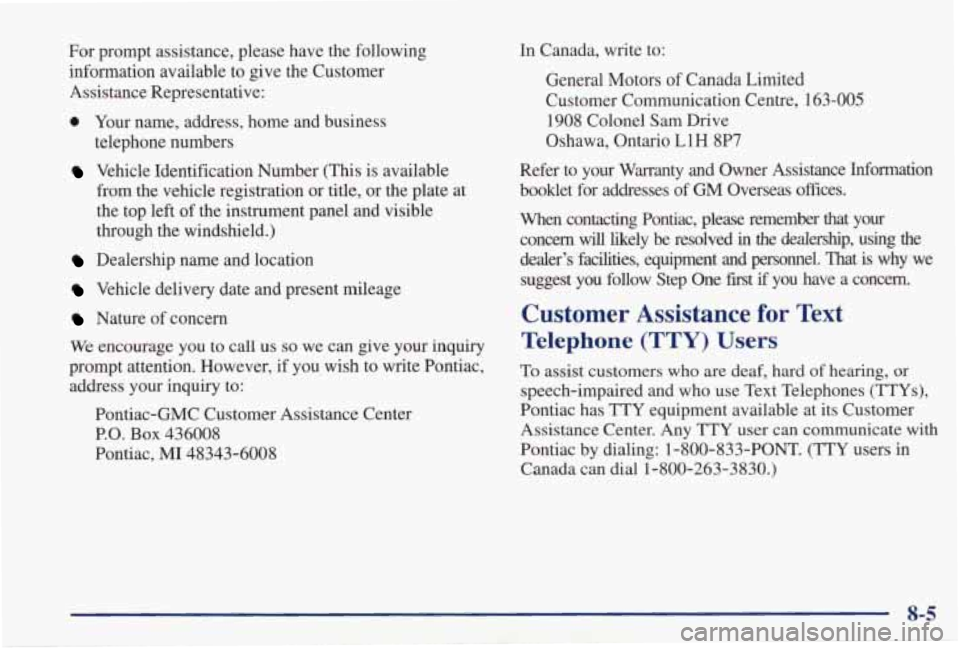1998 PONTIAC GRAND PRIX phone
[x] Cancel search: phonePage 189 of 402

Understanding Radio Reception
AM
The range for most AM stations is greater than for FM,
especially at night. The longer range, however, can
cause stations to interfere with each other.
AM can pick
up noise from things like storms and power lines. Try
reducing the treble to reduce
this noise if you ever get it.
FM Stereo
FM stereo will give you the best sound, but FM signals
will reach only about 10 to 40 miles (16 to 65 km). Tall
buildings or hills can interfere with FM signals, causing
the sound to come and go.
Tips About Your Audio System
Hearing damage from loud noise is almost undetectable
until it is too late. Your hearing can adapt
to higher
volumes of sound. Sound that seems
normal can be loud
and harmful to
your hearing. Take precautions by
adjusting
the volume control on your radio to a safe
sound level before your hearing adapts to it.
To help avoid hearing loss or damage:
0 Adjust the volume control to the lowest setting.
0 Increase volume slowly until you hear comfortably
and clearly.
NOTICE:
Before you add any sound equipment to your
vehicle
-- like a tape player, CB radio, mobile
telephone or two-way radio
-- be sure you can
add what you want.
If you can, it's very
important to do it properly. Added sound
equipment may interfere with the operation
of
your vehicle's engine, Delco Electronics radio or
other systems, and even damage them. Your
vehicle's systems may interfere with the
operation
of sound equipment that has been
added improperly.
So, before adding sound equipment, check with
your dealer and be sure to check Federal rules
covering mobile radio and telephone units.
3-30
Page 191 of 402

Cassettes are subject to wear and the sound quality may
degrade over time. Always make sure the cassette
tape is in
good condition before you have your tape player serviced.
Care of Your Compact Discs
Handle discs carefully. Store them in their original cases
or other protective cases and away from direct sunlight and dust.
If the surface of a disc is soiled, dampen a
clean,
soft cloth in a mild, neutral detergent solution and
clean it, wiping from the center to the edge.
Be sure never to touch the signal surface when handling
discs. Pick up discs by grasping the outer edges or the
edge of the hole and the outer edge.
Care of Your Compact Disc Player
The use of CD lens cleaner discs is not advised, due to
the risk
of contaminating the lens of the CD optics with
lubricants internal to the
CD mechanism.
Fixed Mast Antenna
The fixed mast antenna can withstand most car washes
without being damaged.
If the mast should ever become
slightly bent, you can straighten it out by hand. If the mast is
badly bent,
as it might be by vandals, you should replace it.
Check every once in a while to be sure the mast is still
tightened to the rear quarter panel.
Backglass Antenna (If Equipped)
Your AM-FM antenna is integrated with your rear window
defogger, located
in the rear window. Be sure that the
inside surface of the rear window is not scratched and that
the lines
on the glass are not damaged. If the inside surface
is damaged, it could interfere
with radio reception.
NOTICE:
Do not try to clear frost or other material from
the inside
of the rear window with a razor blade
or anything else that is sharp. This may damage
the rear defogger
grid and affect your radio’s
ability to pick
up stations clearly. The repairs
wouldn’t be covered
by your warranty.
Because this antenna is built into your rear window, there is a
reduced risk of damage caused by car washes and vandals.
If you choose to add a cellular telephone to your vehicle,
and
the antenna needs to be attached to the glass, be sure
that you
do not damage the grid lines for the AM-FM
antenna. There is enough space between the lines to
attach a cellular telephone antenna without interfering
with radio reception.
3-32
Page 195 of 402

Defensive Driving
The best advice anyone can give about driving is:
Drive defensively.
Please
start with a very important safety device in your
Pontiac: Buckle up. (See “Safety Belts” in the Index.) Defensive driving really means “be ready
for anything.”
On city streets, rural roads or freeways, it means
“always expect the unexpected.’’
Assume that pedestrians or other drivers are going
to be
careless and make mistakes. Anticipate what they might
do. Be ready for their mistakes.
Rear-end collisions
are about the most preveztable of
accidents.
Yet they are common. Allow enough
following distance. It’s the best defensive driving
maneuver, in both city and rural driving. You never
know when the vehicle in front of you is going to brake
or turn suddenly.
Defensive driving requires that a driver concentrate
on the driving task. Anything that distracts from the
driving task
-- such as concentrating on a cellular
telephone call, reading, or reaching for something
on the floor -- makes proper defensive driving more
difficult and can even cause a collision, with resulting
injury.
Ask a passenger to help do things like this, or
pull
off the road in a safe place to do them yourself.
These simple defensive driving techniques could save
your life.
4-2
Page 214 of 402

Hydroplaning
Hydroplaning is dangerous. So much water can build up
under your tires that they can actually ride
on the water.
This can happen if the road is wet enough and you’re
going fast enough. When your vehicle is hydroplaning,
it has little or
no contact with the road.
Hydroplaning doesn’t happen often. But it can if your
tires do not have much tread or if the pressure in one or
more is low. It can happen if a lot
of water is standing on
the road. If you can see reflections from trees, telephone
poles or other vehicles, and raindrops “dimple” the water’s surface, there could be hydroplaning.
Hydroplaning usually happens at higher speeds. There
just isn’t a hard and fast rule about hydroplaning. The
best advice is to slow down when it is raining.
Driving Through Deep Standing Water
NOTICE:
If you drive too quickly through deep puddles or
standing water, water can come in through your
engine’s air intake and badly damage your
engine. Never drive through water that is slightly
lower than the underbody
of your vehicle. If you
can’t avoid deep puddles or standing water, drive
through them very slowly.
Some Other Rainy Weather Tips
Besides slowing down, allow some extra following
distance. And be especially careful when you pass another vehicle. Allow yourself more clear room
ahead, and be prepared to have your view restricted
by road spray.
“Tires”
in the Index.)
Have good tires with proper tread depth. (See
4-21
Page 368 of 402

Section 8 Customer Assistance Information
Here you will find out how to contact Pontiac if you need assistance. This section also tells you how to obtain\
service
publications and how to report any safety defects.
8-2
8-3
8-3
8-5
8-6
8-7
8-8
8-9 Pontiac Cares
What Makes Up Pontiac Cares?
Customer Satisfaction Procedure
Customer Assistance for Text Telephone
(TTY) Users
Pontiac Roadside Assistance
Program
Canadian Roadside Assistance
Pontiac Courtesy Transportation
GM Participation in an Alternative
Dispute Resolution Program 8-10
8-
10
8-11
Warranty Information
Reporting Safety Defects to the United
States Government
Reporting Safety Defects to the Canadian Government
8-1
1 Reporting Safety Defects to General Motors
8-11 Ordering Service and Owner Publications
in Canada
Page 369 of 402

Pontiac Cares
1 I
With PONTIAC CARES, you are never more than
a phone call away from having your concern taken
care of.
The PONTIAC CARES philosophy and elements are
designed to make you realize that Pontiac recognizes
you as
a valuable customer, appreciates your purchase
decision, and is dedicated to taking care
of the most
important person
... YOU! PONTIAC CARES is: A
valuable feature that comes with every Pontiac, a feature
that offers
a multitude of benefits that can give you
safety, security,
comfort and convenience.
8-2
Page 372 of 402

For prompt assistance, please have the following information available to give the Customer
Assistance Representative:
0 Your name, address, home and business
telephone numbers
Vehicle Identification Number (This is available
from the vehicle registration or title, or the plate at
the top left of the instrument panel and visible
through the windshield.)
Dealership name and location
Vehicle delivery date and present mileage
Nature of concern
We encourage you to call us so we can give your inquiry
prompt attention. However,
if you, wish to write Pontiac,
address your inquiry to:
Pontiac-GMC Customer Assistance Center
P.O. Box 436008
Pontiac,
MI 48343-6008 In Canada, write to:
General Motors of Canada Limited
Customer Communication Centre, 163-005
1908 Colonel Sam Drive
Oshawa, Ontario
L1H 8P7
Refer to your
Warranty and Owner Assistance Information
booklet for addresses of GM Overseas offices.
When contacting Pontiac, please remember
that your
concern
will likely be resolved in the dealership, using the
dealer’s facilities, equipment and personnel. That is why we
suggest you follow Step One kt
if you have a concern.
Customer Assistance for Text
Telephone (TTY) Users
To assist customers who are deaf, hard of hearing, or
speech-impaired and who use Text Telephones
(TTYs),
Pontiac has TTY equipment available at its Customer
Assistance Center. Any
TTY user can communicate with
Pontiac by dialing: 1-800-833-POW.
(TTY users in
Canada can dial 1-800-263-3830.)
8-5
Page 373 of 402

Pontiac Roadside Assistance Program
L
Security While You Travel
I-800-ROADSILE (1-800-762-3743)
As the proud owner of a new Pontiac vehicle, you are
automatically enrolled in the Pontiac Roadside Assistance program.
This value-added service is
intended to provide you with peace of mind as you
drive in the city or travel the open road.
Pontiac’s Roadside Assistance toll-free number
is
staffed by a team of technically trained advisors, who
are available
24 hours a day, 365 days a year.
We take anxiety out of uncertain situations by providing
minor repair information over the phone or
making
arrangements to tow your vehicle to the nearest
Pontiac dealer.
We will provide the following services for
3 years/36,000 miles
(60 000 km), at no expense to you:
a Fuel delivery
a Keys locked in vehicle
a Tow to nearest dealership for warranty service
a Change a flat tire
Jump starts
Courtesy Transportation -- See Pontiac Courtesy
Transportation section for details
8-6